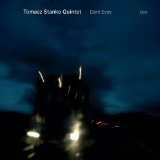Oskar Kokoschka (1886-1980)
Tomasz Stanko (*1942)
Ausstellungskatalog:
Oskar Kokoschka: Early Portraits from Vienna and Berlin, 1909-1914 (Hardcover) by Tobias G. Natter (Editor)
zu bestellen bei: www.amazon.com
Tomasz Stanko Quintet: Dark Eyes
produced by Manfred Eicher ECM 2009
ECM Records GmbH, München
www.ecmrecords.com
Cover image: courtesy of ECM Records
"In the earliest and most compelling works, Kokoschka painted the faces of his sitters with small, wiggly strokes and in sickly colors so they look as if they'd had their skin peeled off. With their bony, veiny, weirdly gesturing hands, they resemble extras from a remake of 'Night of the Living Dead.' (Oscar Wilde's 'Picture of Dorian Gray' also comes to mind.) The gaunt, hollow-eyed 'Martha Hirsch (Dreaming Woman)' projects an eerie, erotic charm, while her male counterparts look like Frankensteinian madmen.
With such pictures, Kokoschka made a place for himself near the start of a long tradition of moralizing portraiture — from Ensor to Ivan Albright to Peter Saul — in which grotesque distortion stands for sickness of the soul".
Ken Johnson in: The New York Times, 2009
"Kunst inspiriert mich mehr als alles andere"
Tomasz Stanko
Tomasz Stanko:
www.tomaszstanko.com
Ausstellungen:
2009 '"Focus: Oskar Kokoschka" in: Neue Galerie, NewYork
www.neuegalerie.org
"Das Titelstück bezieht sich auf ein Gemälde von Oskar Kokoschka, das in diesem Sommer in der österreichisch-deutschen 'Neuen Galerie' in Manhattan zu sehen war."
Götz Bühler in: www.jazzecho.de
The Dark Eyes of Martha Hirsch
Art Review:
"Modernity Met With Hope and Despair" by Ken Johnson in The New York Times, 2009:
www.nytimes.com
Der polnische Trompeter hat mit seinem neuen Quintett eine CD eingespielt, dessen zentrales Stück "The Dark Eyes of Martha Hirsch" durch das Gemälde "Martha Hirsch" (Dreaming Woman) von Oskar Kokoschka aus dem Jahr 1909 inspiriert wurde.
Das Stück beginnt, schreibt David McLean in seiner CD-Review , "with a slow burning arch, thick with ambience and bristling with delicate brush work, Stanko's sombre melody rises and falls with icicle-like accompaniment from Turmarila. The band goes into full swing with a knotty bop melody after a deliberate bass statement from Christensen. Here Stanko returns to the fire of his early career with a ferocious scree and flurry of notes. Sparse chords from Bro and Turmalia provide the space for Louhivourhi's shuffle, before eventually exchanging solo flights. The melody then decreases in intensity, a process punctuated by a few dramatic swells, signalling the track's conclusion in typically fractured Stanko style."
from the CD review by David McLean, 2009:
www.allaboutjazz.com
